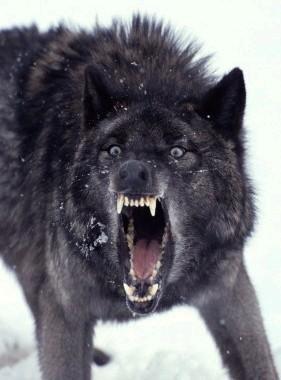Morphological variation within and across species is a subject of great scientific interest. The molecular basis of such variation, including the differences in size, shape, and oftentimes color within a species can be due to numerous factors. Often, random mutations in the melanin biochemical pathway or in the promotor regions of these genes lead to variations in the common agouti phenotype. Occasionally, however, phenotypic variations enter a population as a result of hybridization rather than spontaneous mutation. In wolves, coat color variation probably arose from a surprising pairing…

Fig. 1 - Black wolves may have inheirited their coat color through hybridization with domestic dogs. Photo taken from here
In a recent Science article, Anderson and colleagues attempted to determine the molecular history of the Melanocortin 1 receptor (Mc1r) in North American gray wolves. They studied the melanistic K locus in dogs, coyotes, Italian wolves and North American gray wolves (specifically a small population derived from reintroduced wolves in Yellowstone National Park where genealogy could be easily traced). They noted that the mutation was more frequent in forested areas than on the tundra/taiga, which alone wasn’t exactly earth-shattering news considering a white wolf would stick out like a sore thumb in a dark forest. What was most interesting was that they suspected that the K locus mutation present in the gray wolves in both Italy and from North America as well as coyotes originated from a mutation in domestic dogs. Melanism is very widely distributed in domestic dogs, from Chihuahuas to Great Danes, but is not found in wolves outside of North America who have not been recently hybridized with dogs. It was hybridization between wolves and dogs brought across on the Bering Strait land bridge that allowed wolves the potentially adaptive advantage of having darker coats (or, if it was a trait that was present in ancient Eurasian wolves, it was lost in wolves on that continent after they crossed the bridge).
Interestingly enough, it’s the dog, that animal which has been artificially selected over time to be more suited to life on couches and in cars than one in the wild, which has provided the wolf with a trait so critical to survival. A trait, the paper proposes, that may become even more vital as global warming reduces available tundra territory and prey.
NOTE: This post was written by Lea Mehrkens, an undergraduate in my evolution class. I gave the class the opportunity for extra credit to write a blog-style post on a scientific paper. I think Lea did a nice job on this one... THO
Reference
Anderson, T., vonHoldt, B., Candille, S., Musiani, M., Greco, C., Stahler, D., Smith, D., Padhukasahasram, B., Randi, E., Leonard, J., Bustamante, C., Ostrander, E., Tang, H., Wayne, R., & Barsh, G. (2009). Molecular and Evolutionary History of Melanism in North American Gray Wolves Science, 323 (5919), 1339-1343 DOI: 10.1126/science.1165448
4 comments:
Definitely the best article I've read in years. Who is this Lea MeHERkens girl anyways? She's amazing.
The K locus and MC1R are not the same thing. The K locus is Beta-Defensin-103 (see Candille et al. 2007) and competitively binds against Agouti to MC1R. Fascinating paper and good to see undergrads finding out about it.
it would seem to be equally possible that wolves evolved the K locus color in North America and then crossed the Bering INTO Europe, crossing with domestic dogs as well. this would also explain it's appearance in Coyotes, since dogs are less likely to cross with coyotes than wolves are. The "Canis Niger" (later changed to Canus rufus) clearly had many black individuals to earn it's initial name. Asserting that the color originated in dogs who then went feral and then mated with wolves is POSSIBLE, but it's more likely that a wolf or two were added to the dogs AFTER domestication and then selection for the color spred it about. I note, as an owner of Belgian Sheepdogs, that Clade IV of the dog clade shows "recent" introduction of wolves (the D6/W6) from Russia/Romania. The recent find in Belgium of the "earliest" dog also found skulls that were indistinguishable between wolves and Malinois (one of the D6/W6 breeds). IMO the assertion that the K gene came FROM dogs has more to do with the Italian desire to not have their wolves protected (since they wouldn't be "real" wolves if they were dog hybrids) than any real science.
VR, Lowell1.
In light of today's dismissal of global warming silliness, Lea's closing statement, "...as global warming reduces available tundra territory...", is a good reminder to stick to the facts when posting in a blog that will follow you forever. Otherwise colleagues will be made aware of how frightened you were by noises in the closet and how you, too, drank the boogey-man Kool-Aid.
Post a Comment